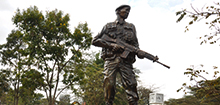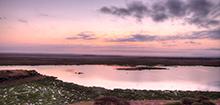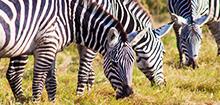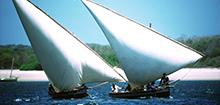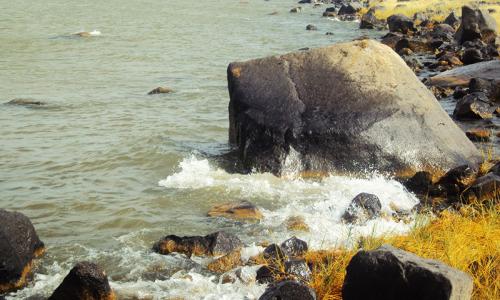
"The Isle of Mystery"
Covered end to end in volcanic ash, the nightly glow of its South Island’s luminous vents has inspired numerous tales of ghosts and evil spirits. The island is home to a profusion of birdlife including 34 species of European migrants most spectacularly viewed as they return home between March and May. At least 23 species breed here, including Goliath heron, and African skimmer, while African open-billed stork, Duck and Gulls feed on the shores and the volcanic island lakes attract lesser flamingos. Birds of prey are also abundant, especially swallow-tailed kites. This park is ideal for game watching and has one of the world’s largest concentrations of crocodiles.
Key features
Climate
Scorching hot and arid (especially December-March) June and July are the coolest months. May-September very strong winds blow both morning and evening. Rainfall less than 250 mm pa and in some places it may not rain for several years.
Vegetation
The vegetation is scant, but some of the sheltered areas are overgrown with think grass and bushes for a short period each year.
Wildlife
The islands are home to hippo, bats and the world’s largest Nile crocodile population.
Birds
More than 350 recorded species including large flocks of flamingos.
Fish
There are 60 recorded species of fish in the lake.
Protected Area Type
Park Size
Climate
Altitude
When to go
What to take with you
- All supplies: especially fuel (the last fuel stations are in Marsabit or Maralal), food and water.
- Also useful are: camping equipment, breakdown equipment and medical kit as well as camera, binoculars, hat, sunscreen, sunglasses, insect repellent and guidebooks.
How to get there
- By Air: Access to Lake Turkana is usually by air and there are two all-weather airstrips. Also in Loiyangalani
- By road: The Lake is a three day drive from Nairobi via Marsabit and North Horr, or Maralal and South Horr. Alternatively travel by road from Nairobi to Kalokol on the lake’s western shores, via Kitale and Lodwar. From Kalokol boat hire services are available to Central Island.
Attractions
<p><strong>Crocodile Kingdom</strong></p>
<p>Survivors of an epoch long before mankind, Lake Turkana’s estimated 12,000 crocodiles have not changed in 130 million years. Despite their monstrous size and formidable appearance they are generally inoffensive creatures living in perfect harmony with their environment and feeding on the lake’s prolific fish.</p>
<p><strong>The world’s largest crocodile nursery</strong></p>
<p>Crocodiles breed on the shores of the island’s crater lakes between April and May. The baby crocodiles can be heard squeaking in their eggs, which are buried deep beneath the sand to escape the predatory attentions of monitor lizards and raptors. Their cries bring their parents scurrying to dig them out and carry them down to the water’s edge, where they spend their first months.</p>
<p><strong>Venomous reptiles and prehistoric fish</strong></p>
<p>Turkana is home to some of the world’s most venomous reptiles, including saw-scaled viper, night and puff adder and cobra. There are also many species of fish including huge Nile perch and large tilapia. Puffer fish, a group normally found in seawater, indicate Turkana’s prehistoric connection to the Red Sea.</p>
<p><strong>Abundant birdlife</strong></p>
<p>The islands are home to a profusion of birdlife (over 84 water bird species), including 34 species of European migrants most spectacularly viewed as they return home between March and May. At least 23 species breed here, including Goliath heron, and African skimmer, while African open-billed stork, Duck and Gulls feed on the shores and the volcanic island lakes attract lesser flamingos. Birds of prey are also abundant, especially swallow-tailed kites.</p>
<p> </p>
Campsites
Privately Owned Campsites & Lodges
Park Entry Fee
South Island National Park | Citizen | Resident | Non-Resident | |||
Adults KSH | Child KSH | Adults KSH | Child KSH | Adults USD | Child USD | |
300 | 125 | 300 | 125 | 22 | 13 | |
* Kindly refer to the KWS Conservation Fees document below for other services and charges
* Modes of Payment; Pay for your entry to any of our Parks or Reserves via Ecitizen government platform
* Create a personal account on the eCitizen Government platform by visiting https://kws.ecitizen.go.ke and make park payments in advance for a fast and convenient park entry
Park Resources
Postal Address:
The warden,
P. O. Box 219,
Lodwar.
Tel: (Lodwar) +254 (54) 21223
Email address: sibiloi@kws.go.ke
Warden south Island national park: jaskipkilely@kws.go.ke

